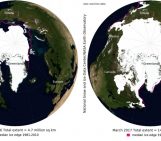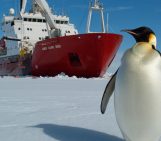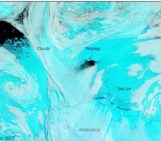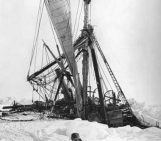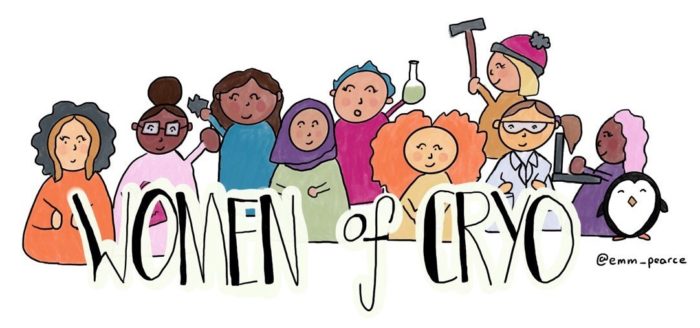
Women make up 50.8% of the worlds population, yet fewer than 30% of the world’s researchers are women. Of this percentage, BAME (Black Asia and Minority Ethnic) comprise around 5%, with less than 1% represented in geoscience faculty positions.
The divide between women in the population and women in STEM needs to be addressed. Through a series of blog posts we hope to raise the voice of women in the cryosphere community, and spread awareness of the amazing work they do.
This Women of Cryo blog post will introduce you to Virginia ‘Ginny’ Fiennes. Ginny was a renowned explorer in the latter part of the 20th century, but her achievements, resilience and progressive approach to women’s roles in exploration often lie in the shadow of her famous husband.
Perhaps the surname Fiennes rings familiar in your ears, from the renowned explorer Ranulph Fiennes. Virginia’s husband, the polar explorer Sir Ranulph Fiennes, led many expeditions in hot deserts and cold regions, through the last 30 years of the 20th century. But behind Ranulph Fiennes’ heroic accomplishments was always his wife. Ginny was the one who originated and inspired the planning, had the final say in choosing the teams, and organised the routes and schedules. She was the base leader in Africa, Arabia, Antarctica and the Arctic for many years, and specialised in communications1.
As such, Ginny’s efforts and exploration was recognised in 1985, when she became the first woman ever to be invited to join the respected ranks of the Antarctic Club. Two years later, she became the first woman to receive the Polar medal, an award given to individuals who have given outstanding achievements and service to the UK in the field of polar research1.
This polar medal was in recognition of her organisation of the Transglobe expedition which circumnavigated the world along its polar axis crossing Antarctica and the Arctic ocean (going from pole to pole) on the same trip. It took seven years of planning to finally realise her dream, crossing Antarctica, and the Arctic ocean through the North-West Passage, a journey of 35,000 miles lasting three years. (Not to mention doing this whilst ensuring the safety of Bothie, the jack Russel, the only dog to have been to both the North and South pole!)
‘And all that seven years, right up until the last month of the expedition, her resilience and her spark…, she was the lynch pin in the middle to keep the whole thing going, even when it looked dreadful” – Ranulph Fiennes2
In addition to Ginny spending many long winter months in the Arctic and Antarctic, operating mostly alone in extreme polar conditions, Ginny carried out ground-breaking research into the use of Very Low Frequency (VLF) radio propagation, for the British Antarctic Survey and Sheffield University. The data gathered with VLF radio in Antarctica is now used by more than 35 institutes all around the world, allowing the recording of global lightning strikes, atmospheric conditions from solar winds and long-distance communication3.
To become Britain’s most experienced polar radio operator, Ginny took marine radio officer courses and joined the WRAC Territorials. She set up and maintained 80 ft radio masts in the Arctic and Antarctic, often in high winds and temperatures of -50°C. Through her understanding of VLF radio, Ginny was instrumental in saving the lives of a group of South African scientists lost to the north of her isolated Antarctic base in 19802.
After Ginny’s death in 2004 from breast cancer, she was honoured by the naming of Mount Fiennes; a 2500 m high summit on the eastern side of the Elgar Uplands on Alexander Island, Antarctica4.
Ginny Fiennes was an understated individual with a renowned sense of humour, who ensured her husband’s success came before her own wellbeing. For instance, twice, Ranulph returned to his base during his expeditions in Antarctica to find Ginny passed out from carbon monoxide fumes5. Additionally, when hearing her breast cancer diagnosis, Ginny did not tell Ranulph, who was in the midst of running seven marathons on seven continents, as she did not want him to lose his focus5.
Ginny is an inspirational woman in the cryosphere community, she set the precedent that women could have their own great ideas of exploration and accomplish these. Though at the time of Ginny’s adventures she was often the unrecognised power behind Ranulph’s expeditions, in today’s age, she inspires women to complete such expeditions independently. As such, 15 women have since received the polar medal, and many more have had the opportunity to travel to both the top and bottom of the world in pursuit of adventure and research.
Let us leave you with a tribute movie made in her honor…
References
- The Times, Virginia Fiennes Obituary 24 February 2004
- Ginny in the Hut – BBC Radio 4 broadcast, 11th September 2015
- https://www.bas.ac.uk/polar-operations/sites-and-facilities/facility/halley/vlf-receiver/
- Friends of Scott Polar Research Institute, Celene Pickard
- No Such Thing as a fish Podcast episode 390 – No Such Thing As The Chronicles of Chelmsford
Edited by Marie Cavitte
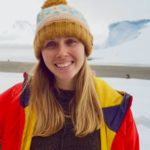 Emma Pearce is a PhD student at the University of Leeds, UK. She investigates the application of using the seismic geophysical technique Full Waveform Inversion (FWI) to model firn. When she isn’t in the office or on fieldwork, Emma can be found climbing, crafting, or being a mum to her pet hamster. She tweets at @emm_pearce and can be contacted by email on eeevep@leeds.ac.uk
Emma Pearce is a PhD student at the University of Leeds, UK. She investigates the application of using the seismic geophysical technique Full Waveform Inversion (FWI) to model firn. When she isn’t in the office or on fieldwork, Emma can be found climbing, crafting, or being a mum to her pet hamster. She tweets at @emm_pearce and can be contacted by email on eeevep@leeds.ac.uk

